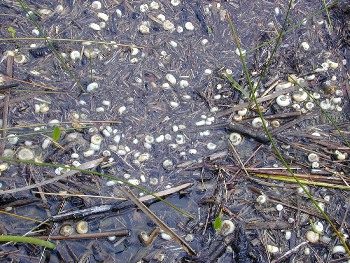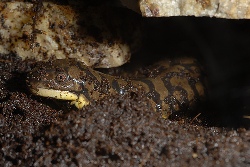Nutrition
The food of this salamander includes worms,
snails,
insects,
and slugs. Captive
 specimens will eat smaller salamanders,
frogs, newborn
mice, and baby
snakes, and it is likely that
similar items are also eaten in the wild when the opportunity
presents itself. Tiger salamander larvae begin feeding on small
crustaceans (e.g. ostracods, and copepods) and insect larvae but
soon grow large enough to eat tadpoles and smaller salamander
larvae, and even in small fish.
specimens will eat smaller salamanders,
frogs, newborn
mice, and baby
snakes, and it is likely that
similar items are also eaten in the wild when the opportunity
presents itself. Tiger salamander larvae begin feeding on small
crustaceans (e.g. ostracods, and copepods) and insect larvae but
soon grow large enough to eat tadpoles and smaller salamander
larvae, and even in small fish.
Circulatory System of the Tiger Salamander :
Amphibians and reptiles have a
three-chambered heart. The three-chambered heart
consists of two atria and one ventricle. Blood
leaving the ventricle passes into one of two vessels. It
either travels through the pulmonary arteries leading to
the lungs or through a forked aorta leading to the rest
of the body. Oxygenated blood returning to the heart
from the lungs through the pulmonary vein passes into
the left atrium, while deoxygenated blood returning from
the body through the sinus venosus passes into the right
atrium. Both atria empty into the single ventricle,
mixing the oxygen-rich blood returning from the lungs
with the oxygen-depleted blood from the body tissues.
While this system assures that some blood always passes s
to the lungs and then back to the heart, the mixing of
blood in the single ventricle means the organs are not
getting blood saturated with oxygen. This is not as
efficient as a four-chambered system, which keeps the
two circuits separate, but it is sufficient for these
cold-blooded organisms.
s
to the lungs and then back to the heart, the mixing of
blood in the single ventricle means the organs are not
getting blood saturated with oxygen. This is not as
efficient as a four-chambered system, which keeps the
two circuits separate, but it is sufficient for these
cold-blooded organisms.
If you would like to learn about the reproduction of the tiger salamander click here.
To go back to adaption of the tiger salamander click here
To go back to the home page click here